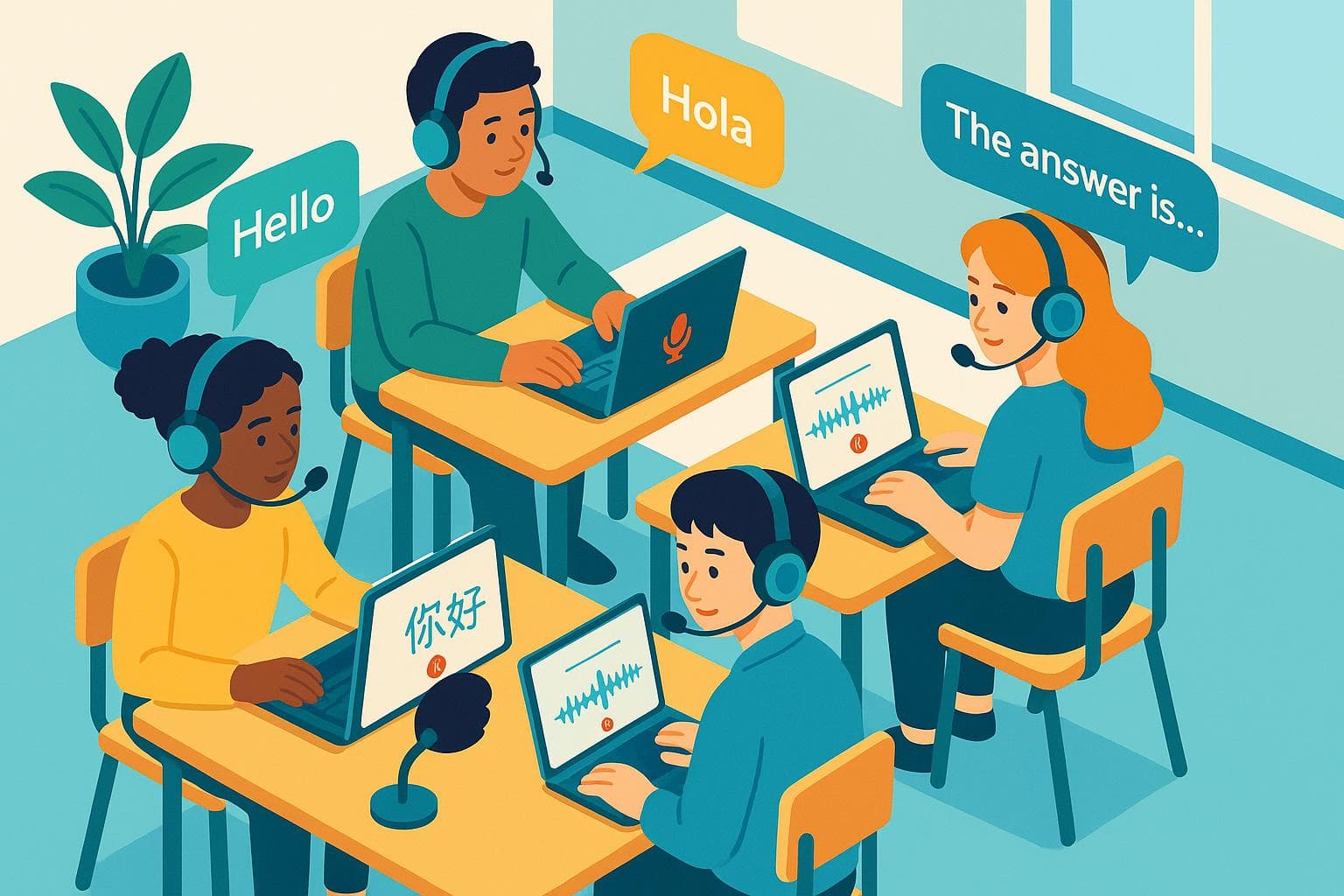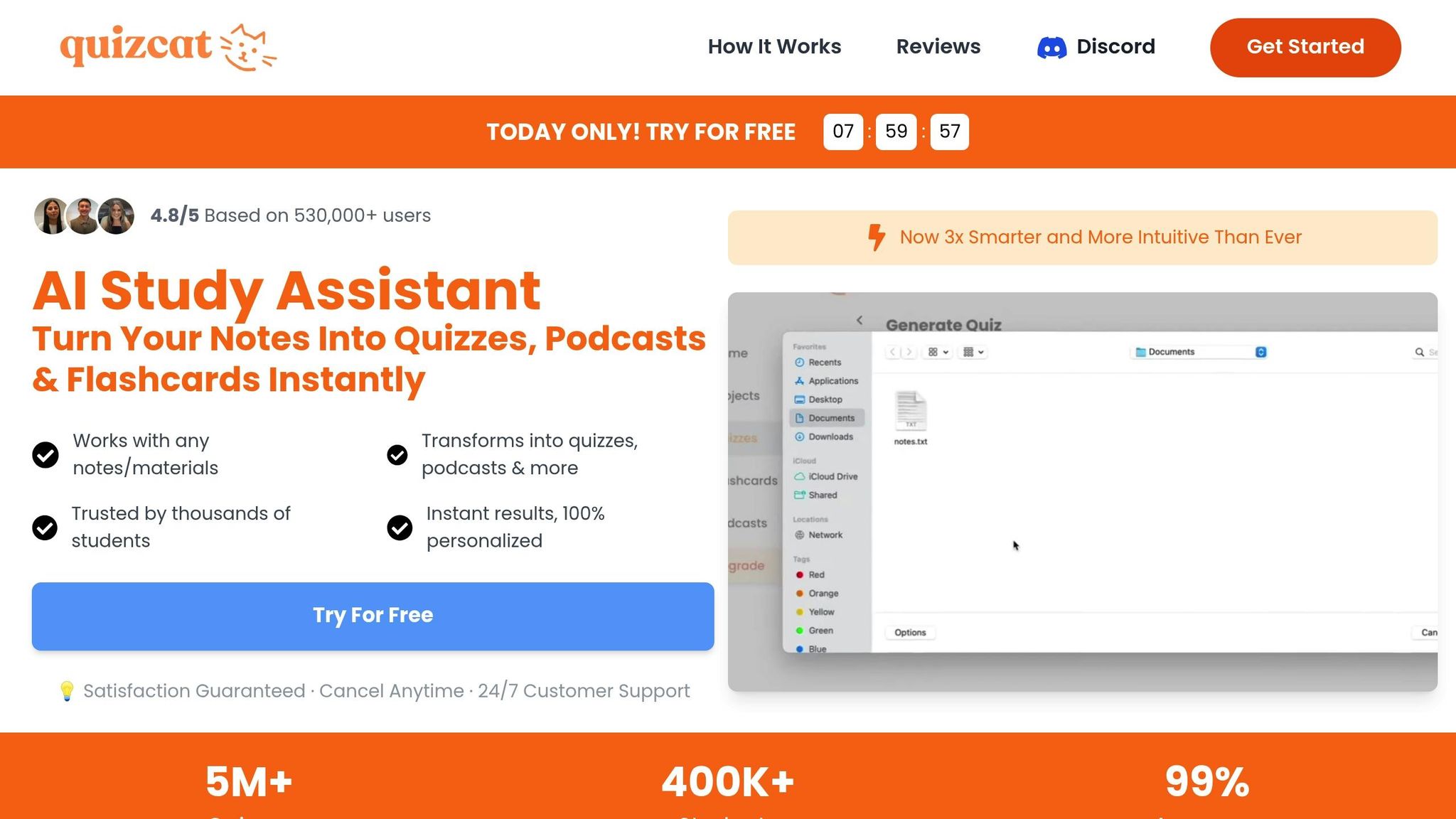
How Multilingual Speech Recognition Helps Students Learn
Multilingual speech recognition tools are transforming education by making language learning and studying more interactive and effective. Here’s how they help:
- Real-time Feedback: Instantly corrects pronunciation, grammar, and vocabulary.
- Flexible Practice: Learn at your own pace, anytime, anywhere.
- Interactive Study Aids: Converts notes into quizzes, flashcards, and even podcasts.
- STEM Support: Simplifies technical terms, automates note-taking, and transcribes lectures.
- Learning Differences: Assists students with dyslexia or auditory processing challenges through text conversion and immediate feedback.
Quick Example: Tools like QuizCat AI let students upload notes, create flashcards, and even generate podcasts, making studying more engaging and efficient.
Magical AI Tools to Empower ELLs, MLLs
Speech Recognition Tools in Language Learning
Speech recognition technology has become a game-changer in language learning, offering personalized feedback that helps learners sharpen their skills. By analyzing spoken language with remarkable precision, these tools support essential aspects of language development.
Improving Pronunciation
One standout advantage of speech recognition tools is their ability to provide real-time feedback on pronunciation. They break down spoken language into specific elements, making it easier for learners to identify and correct mistakes:
- Sound Recognition: Matches phonemes to native speaker patterns for accuracy.
- Stress Patterns: Highlights word stress and intonation issues.
- Rhythm Analysis: Evaluates speech tempo and natural flow.
Research shows that students using speech recognition tools achieve better pronunciation accuracy and retain vocabulary more effectively than those relying solely on traditional methods.
Strengthening Grammar and Vocabulary
These tools go beyond pronunciation, helping learners refine grammar and expand vocabulary. Through interactive exercises that require verbal responses, the systems analyze spoken input and provide targeted corrections. Here's how they support language development:
| Learning Focus | Tool Function | Benefit for Learners |
|---|---|---|
| Grammar Practice | Detects errors | Helps correct structural issues |
| Vocabulary Building | Analyzes word usage | Boosts retention through context |
| Sentence Construction | Recognizes patterns | Improves understanding of structure |
This combination of grammar refinement and vocabulary enrichment makes speech recognition tools a versatile asset for language learners.
Encouraging Consistent Speaking Practice
Speech recognition tools also promote regular speaking practice, which is crucial for fluency. By incorporating gamified features, they motivate learners to stay engaged. Some of the key benefits include:
- Convenient Practice: Learners can practice speaking anytime, anywhere, without needing a partner, allowing for quicker progress.
- Confidence Boost: Practicing in private reduces fear of making mistakes, encouraging learners to experiment with pronunciation and grammar.
- Progress Monitoring: Advanced tracking features highlight improvements and pinpoint areas that need more attention, keeping learners motivated.
For a well-rounded learning experience, tools like QuizCat AI can transform study materials into custom quizzes and flashcards, complementing speaking exercises and reinforcing language skills.
Using Speech Recognition in Different Subjects
Speech recognition technology has expanded beyond its role in language learning to become a valuable tool across various academic disciplines. It not only supports language acquisition but also helps students tackle complex topics and overcome diverse learning challenges.
STEM Subject Support
In STEM fields, speech recognition plays a pivotal role by simplifying technical jargon and enhancing comprehension through real-time transcription and clarification.
| Learning Activity | Speech Recognition Benefits | Student Impact |
|---|---|---|
| Lecture Capture | Real-time transcription of scientific terms | Easier retention of complex vocabulary |
| Math Problem Solving | Voice-activated equation transcription | Reduces mental strain by automating equation handling |
| Lab Work | Hands-free note-taking during experiments | Boosts accuracy in documenting findings |
This technology allows students to focus on understanding concepts rather than being bogged down by manual note-taking. For instance, in biology lectures, speech recognition tools can transcribe intricate processes for later review. This is especially helpful for international students, offering them the ability to translate technical terms into their native language for better understanding. Research even highlights a 3.55% relative decrease in word error rates for technical content, making it particularly effective in STEM settings. Additionally, its versatility ensures it supports learners with unique needs.
Help for Learning Differences
Speech recognition also shines in helping students with learning challenges like dyslexia or auditory processing disorders. It provides alternative ways to interact with educational material, offering several advantages:
- Text Conversion: Converts spoken instructions into written text, alleviating difficulties associated with reading.
- Immediate Feedback: Delivers real-time transcription during lectures, aiding comprehension.
- Flexible Learning: Enables students to process information at their own pace.
Studies show that students using speech recognition tools experience better understanding and memory retention compared to traditional methods. The ability of these tools to handle various languages and accents makes them particularly useful in diverse classrooms.
Tools like QuizCat AI take this a step further by transforming transcribed content into interactive study aids, such as quizzes, flashcards, and podcasts. By integrating speech recognition with adaptive learning technologies, educators can create a more inclusive environment that caters to a wide range of learning preferences and needs.
sbb-itb-1e479da
Getting the Most from Speech Recognition Tools
Adding Speech Tools to Study Time
Incorporating speech recognition tools into daily study routines can make learning more interactive and effective. These tools can be used in several ways:
| Study Activity | How to Use Speech Recognition | Learning Advantage |
|---|---|---|
| Note Review | Record key concepts and listen back | Reinforces understanding through listening |
| Pronunciation Practice | Speak terms and check recognition accuracy | Enhances pronunciation and vocabulary |
| Comprehension Check | Read aloud and compare transcriptions | Highlights areas needing further clarity |
For best results, set aside regular practice times and focus on speaking clearly. Pairing speech tools with platforms like QuizCat AI can further boost study efficiency.
Using QuizCat AI with Speech Recognition

QuizCat AI takes the benefits of speech recognition to the next level, turning spoken inputs into versatile study aids. With a stellar 4.8/5 rating from over 530,000 users, it transforms verbal notes into comprehensive learning materials.
"The flashcards are crazy good, but the podcast feature is my fave. It reads my notes back to me while I'm at the gym or driving. Talk about multitasking!"
– Ethan Blake
Powered by advanced AI, QuizCat AI delivers 99% accuracy, making it a reliable tool for handling technical terms and multiple languages. Key features include:
- Uploading lecture recordings and study notes for processing
- Mobile-friendly access to podcasts created from notes
- Tracking progress through quiz performance analytics
In July 2024, student Olivia Brooks used the platform to convert her notes into podcasts, making her bus rides productive study sessions.
"A lifesaver during finals. Uploaded my notes, hit 'create,' and BOOM - quizzes and flashcards ready to go. It's like having a personal tutor 24/7."
– Jake Harrison
Another example comes from Ryan Kim, who in November 2024 found that automatically generated flashcards drastically cut down his preparation time, allowing him to concentrate more on learning.
Conclusion: Improve Your Learning Results
Speech recognition is changing the game for language learning and academic success. Pairing these tools with QuizCat AI creates a dynamic study environment tailored to fit individual learning styles and goals.
When combined, speech recognition and AI-powered tools provide three standout benefits:
| Learning Aspect | Benefit | Impact |
|---|---|---|
| Pronunciation | Real-time feedback | Boosts confidence in speaking different languages |
| Comprehension | Multi-format learning | Strengthens understanding through diverse methods |
| Efficiency | Automated content creation | Saves time while ensuring accuracy in study materials |
These features make learning smarter and more effective. As Ethan Blake puts it:
"The flashcards are crazy good, but the podcast feature is my fave. It reads my notes back to me while I'm at the gym or driving. Talk about multitasking!"
Take the first step toward smarter studying with QuizCat AI. Start your 3-day free trial, upload your materials, and watch as the AI turns them into interactive tools. Combine advanced speech recognition with AI-powered features to take your academic performance to the next level.
FAQs
How can multilingual speech recognition tools help students with learning challenges, such as dyslexia, improve language skills?
Multilingual speech recognition tools are a game-changer for students facing learning challenges like dyslexia. By offering real-time transcription and pronunciation feedback, these tools bridge the gap between spoken and written words. This consistent support helps improve reading and comprehension skills while allowing students to learn at their own pace.
On top of that, speech recognition eases the stress of traditional writing tasks. Instead of struggling with pen and paper, students can focus on expressing their thoughts verbally. Over time, this approach boosts their confidence and makes it easier to engage with language learning and other academic subjects.
How does multilingual speech recognition support students in learning new languages and improving comprehension across subjects?
Multilingual speech recognition tools offer students an engaging and accessible way to learn new languages while boosting their understanding of various subjects. By converting spoken words into text with precision, these tools help learners refine their pronunciation, sharpen listening skills, and enhance comprehension - all in real-time. Plus, the ability to practice and get instant feedback makes studying more interactive and effective.
Beyond language learning, these tools are a game-changer for students tackling complex lectures or materials presented in different languages. For international students or those in multilingual settings, they break down language barriers, creating opportunities for deeper understanding and more meaningful learning experiences.
How can students effectively use multilingual speech recognition tools in their daily studies?
Students can get the most out of multilingual speech recognition tools by weaving them into their daily study habits. For example, these tools are great for practicing pronunciation when learning a new language, helping students speak more naturally and confidently. They’re also perfect for transcribing spoken lectures or discussions, making it simpler to revisit and absorb important points later on.
Pairing speech recognition with tools like Quizcat AI can take studying to the next level. With Quizcat AI, students can upload study materials and turn them into interactive quizzes, flashcards, or even podcasts. This approach not only makes reviewing concepts and testing knowledge more engaging but also helps pinpoint areas that need extra attention. By blending these tools, students create a more dynamic and effective learning experience.
